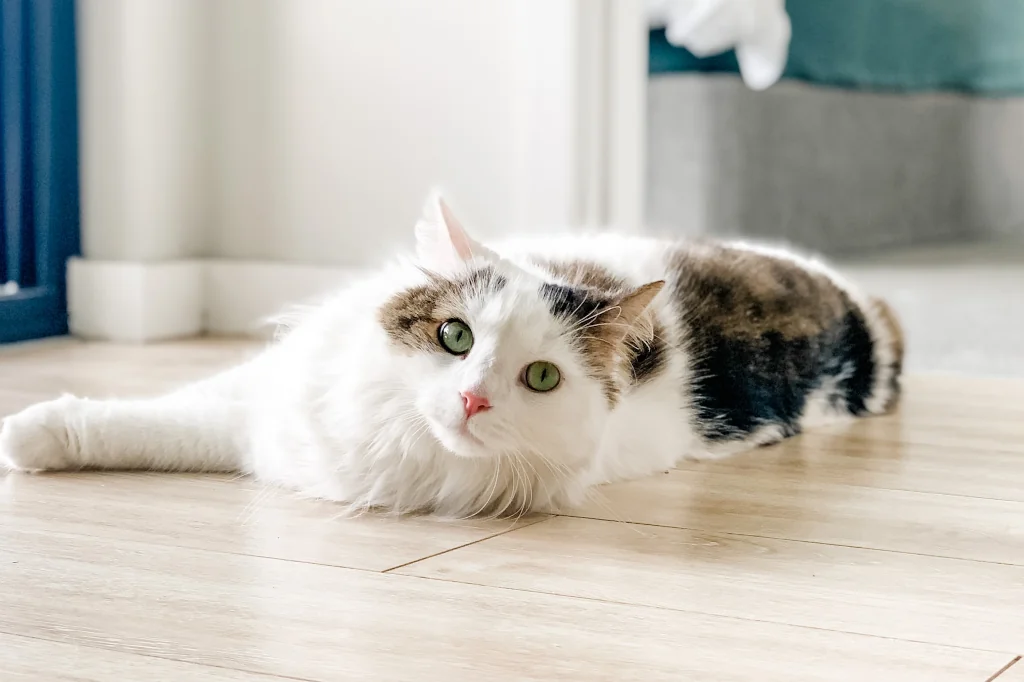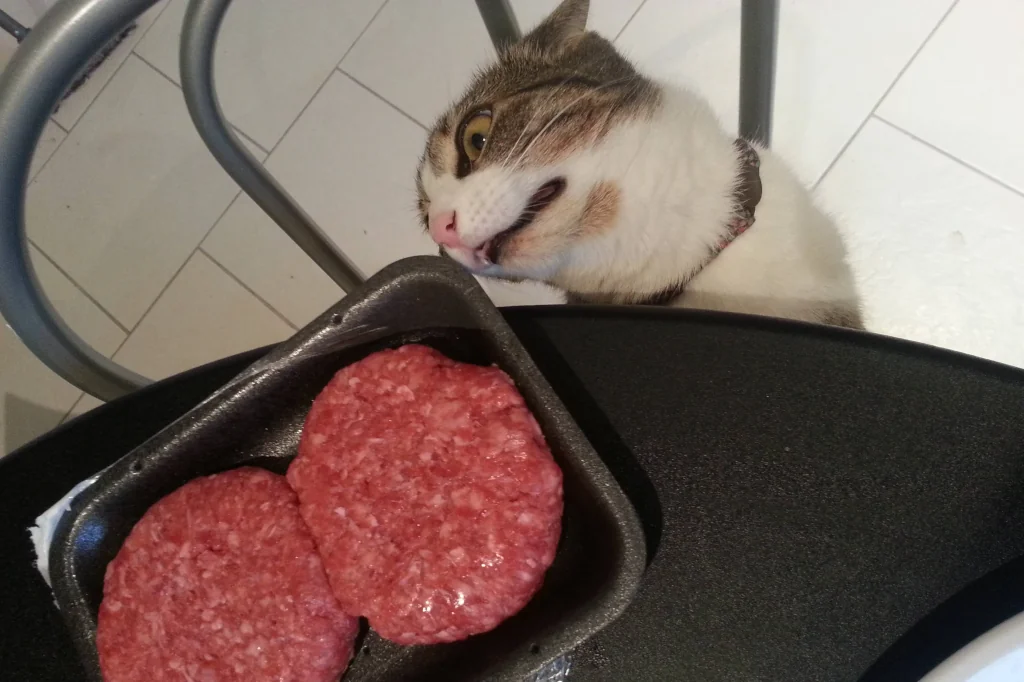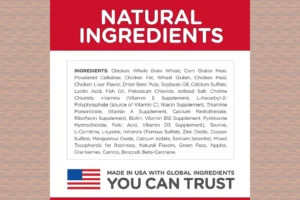Disclosure: We may earn a commission from helpful, relevant links in our content. No cost to you. See our privacy policy.
Watching your fluffy feline friend nuzzle their food dish, you might wonder what role fats play in their diet.
Yes, cats are known for their carnivorous leanings, but fats? They seem almost…human in their dietary preferences, right? Navigating the cat food aisle can feel like a trek through the jungle, as you wrestle with questions like ‘how much fat is too much?’ and ‘are certain fats harmful to my cat?’.
Well, dear reader, prepare to be enlightened. This guide will help you clear the confusing web of feline nutrition, specifically focusing on the role of fats.

Why Do Cats Need Fats in Their Diet?
You might be surprised to learn that fats are an essential part of a cat’s diet. Here’s why: Fats provide the most concentrated source of dietary energy for cats.
They need this energy for everything – from chasing laser pointers to maintaining body temperature. Moreover, certain fats, called essential fatty acids, are crucial for maintaining healthy skin and coat, supporting kidney function, and promoting overall well-being.
Not all fats are created equal, of course, but we’ll get to that. In a nutshell, a diet deficient in fats might leave your feline friend less frisky and their fur less glossy. That’s certainly not what we want, is it?
What Types of Fats Are Essential for Your Cat?
In the grand stage of fats, two essential fatty acids take the limelight for our feline friends – Omega-3 and Omega-6. Here’s why these fats deserve applause:
- Omega-3 fatty acids: Known for their anti-inflammatory properties, Omega-3s are key players in supporting brain health, heart function, and kidney health. They can be found in fish oils, notably from salmon and sardines.
- Omega-6 fatty acids: These fats are crucial for skin and coat health, cell function, and reproduction. They’re abundant in sources like poultry fat and sunflower oil.
Interestingly, cats can’t make these essential fatty acids on their own – they need to get them from their diet. That’s why it’s important to ensure that your cat’s food includes these key ingredients.
Are Some Fats Harmful for Cats?
Indeed, not all fats are the same, and some can be harmful.
Let’s take Mrs. Davis from next door as an example. Mrs. Davis loves treating her cat, Mittens, to table scraps from her meals. However, these human foods often contain fats that are difficult for cats to digest, like trans fats and certain saturated fats.
Trans fats, often found in fried and processed foods, can lead to obesity and heart disease in cats, just as they can in humans. Similarly, large amounts of certain types of saturated fats (like the kind in fast food) are a no-no.

So, it’s important to stick to cat-specific food, and limit treats and human food. The fats in cat food are carefully balanced to ensure they’re getting what they need, and not what could harm them. If Mrs. Davis continues treating Mittens with table scraps, she might unknowingly compromise Mittens’ health.
We certainly wouldn’t want that, so let’s take a look at how to choose cat food that has some healthy fats for your cat.
What Types of Fats Should You Look For in Cat Food?
As a discerning cat parent, you should ensure that your cat’s food contains the right types of fats. Just like with proteins and carbohydrates, learning about the right types of fats is essential.
Omega-3 and Omega-6 fatty acids should be on top of your list, as we mentioned earlier. Scan the ingredients list for fish oil or flaxseed (for Omega-3) and poultry fat or sunflower oil (for Omega-6).
However, here’s a pro-tip that most folks miss: also look out for ‘named’ fat sources in the ingredients. ‘Chicken fat’ or ‘salmon oil’ is better than generic ‘animal fat’. This specificity indicates a higher quality product, and you’ll know exactly what your cat is consuming.
Remember, your little furball relies on you for their nutritional needs. The better the fats in their diet, the shinier their coat, the healthier their skin, and the happier they are!
Understanding what to look for is half the battle. To help you make the right choice, here are some products that we recommend, all of which contain the essential fats your cat needs:
- Purina ONE Natural Dry Cat Food. This dry cat food provides a natural recipe packed with real chicken, plus it includes Omega-6 fatty acids to help keep your cat’s skin healthy and their coat shiny.
- Blue Buffalo Wilderness High Protein Dry Cat Food. This product offers real chicken as the first ingredient and also includes flaxseed, which is a great source of Omega-3 fatty acids.
- Royal Canin Feline Health Nutrition Dry Cat Food. It’s tailored for adult indoor cats and offers a balance of proteins, fats, and carbohydrates. It also includes fish oil as a source of Omega-3 fatty acids.
What Is a Good Fat Content for Cat Food?
When you’re scouring the shelves for the right cat food, you’ll want to look for one with a balanced fat content.
A typical adult cat food should contain between 9% to 15% fat, while kitten food can have a little more, due to high energy needs.
As far as specific fats, a good Omega-3s percentage in cat food is about 0.4% in cat food, and for Omega-6, it’s about 1 to 4%.
Remember, the source of fat matters just as much as the quantity. Opt for foods that contain named fats, like ‘chicken fat’, and essential fatty acids, like Omega-3 and Omega-6.
Suggested read: Essential Vitamins and Minerals for Cats
How Much Fat Is Too Much for a Cat?
Every cat is an individual with unique nutritional needs, which can be influenced by their age, breed, weight, and activity level.
However, on average, adult cats should get about 20% of their daily calories from fat. For kittens, who need more energy for growth and play, the number is a bit higher, around 25%.
Excess fat can lead to obesity, which brings a slew of potential health problems, including diabetes, heart disease, and arthritis. So while fats are essential for your cat, like most things in life, they should be served in moderation.
Even Omega fatty acids can cause adverse effects if given too much, or in too high of concentration, both for dogs or cats. But the benefits are exceptional from Omegas. Remember that all dietary supplements have a potential of causing side effects, and at this time, there is not enough data to set a safe upper limit for cats, so as always, just don’t overdo it.
I remember a time with my own cat, Smokey. He’s an active, playful fella who loves chasing laser pointers and exploring every nook and cranny of the house. However, there was a period when I noticed he was slowing down, appearing less energetic and interested in play.
Concerned, I took him to the vet, where I found out that I had been over-feeding him, resulting in him gaining excess weight. This served as a wake-up call and taught me the importance of a balanced diet – not just for us humans, but for our furry friends as well.
Suggested read: Cat Food Label Guidelines
Pay Attention to Fat, but Not Too Much
As a responsible pet parent, it’s crucial to find the right balance in our pets’ diets. While fats are an integral part of their nutrition, they should not overshadow the other necessary nutrients.
Regular vet check-ups, a keen eye on their behavior, and a constant effort to educate ourselves about their nutritional needs are key. Remember, an appropriate diet is one of the best gifts you can give to your cat – the gift of health, vitality, and long, happy life.
Now, I know we’ve covered a lot of ground in this post, so here’s a quick reference table to summarize the key takeaways:
| Type of Fat | Common Sources | Benefits | Recommended Percentage in Cat Food |
|---|---|---|---|
| Omega-3 Fatty Acids | Fish oil, Flaxseed | Enhance brain, heart, and kidney health | Around 0.4% |
| Omega-6 Fatty Acids | Poultry fat, Sunflower oil | Improve skin, coat, and cellular health | Around 1-4% |
| Saturated Fats | Animal fats, Fish oil, Dairy products | Provide energy, help nutrient absorption | Around 9-15% |
| Unsaturated Fats | Fish oil, Canola oil, Sunflower oil | Support cell function, energy provision, nutrient absorption | Varied, but balanced with saturated fats |
After all, it’s not just about feeding our cats; it’s about nourishing them, and that’s a responsibility that every pet parent should gladly embrace.
Might be interested in: Raw Cat Food Pros & Cons
FAQs
What fat is best for cats?
The best fats for cats are Omega-3 and Omega-6 fatty acids. These can be found in fish oils, flaxseed, poultry fat, and sunflower oil.
What happens if a cat doesn’t get enough fat in their diet?
If a cat doesn’t get enough fat in their diet, they may develop a dull coat, dry skin, and they may be more susceptible to infections due to a weakened immune system.
Do cats need more fat or protein in their diets?
Cats require both fat and protein in their diets. However, protein is a crucial part of a cat’s diet, as they are obligate carnivores. They typically need more protein than fat, with diet comprising about 35-50% protein and 9-15% fat.
Alex, a passionate animal lover, has experience in training and understanding animal behavior. As a proud pet parent to two dogs and three cats, he founded AnimalReport.net to share insights from animal experts and expand his knowledge of the animal kingdom.




